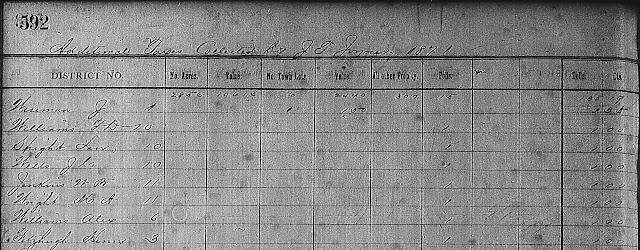Last Saturday, I again braved the intense heat and went to
my local Family History Center
to finish scanning the remaining petition files on the microfilm I
ordered.
A couple of days ago I finished
transcribing Mahala Grantham’s file and began on Sarah Daniel, widow of
Ethelred Daniel’s file.
Today, I finished
transcribing her file, afterwards took a break--watching some of the men’s
gymnastics qualifying rounds--and will start on another petition file.
Since on the first go around with these files, I only made
scans of about 5 files there isn’t much hanging over me for that day’s set of
scans. Last week, I’d been able to
finish with my scanning and have about seven or so files to transcribe from
that batch.
My plan once I finish transcribing the files is to then
enter the metes and bounds descriptions into DeedMapper and hopefully place it
logically in place with my other plats.
Then I’ll begin the process again by ordering another roll of microfilm
of petitions from my list of missing land owners.
Evernote use
In a previous post I mentioned that I’d begun using
Evernote
and was trying out how it would work with my genealogy research.
I joined a couple of
Evernote groups with the
idea that I could troubleshoot any issues that might crop up.
I’ve experimented with using it in my
research and have to say that there’s a steep learning curve at least for me in
using it.
Unfortunately, I’ve discovered that I don’t have enough
space on my tablet to install it and so am not able to test out how the sync
feature works. The online help I haven’t
found to be helpful in answering my questions.
The tutorials only seem to spark ideas, and are lacking in step-by-step
details of how a particular feature works.
I learned in using the program that if an image is copied
and pasted into a new note that text can’t be added above or below as far as I
can tell.
When I first installed
Evernote I tried out the web clipping tool and was disappointed in how it
worked.
Anything I searched online, either
in the groups I’ve joined,
Evernote’s help files, or tutorials never seemed to fully
explain how it worked.
So I spent a lot
of time flailing around clipping things.
The clippings, I would find later were a lousy image of what I’d clipped
and this was disappointing.
Eventually, I was able to use the clipping tool effectively,
but it’s taken a lot of work and just playing around. I get that help files with any software are the
last things to get written. But what
doesn’t make sense to me is this program has been around seemingly forever, so
long that there are people who have outgrown it and are moving on to something
else, so why aren’t the tutorials better in explaining how features work?
As a work around to figuring out how features work with
Evernote, I’ve taken to posing my questions to Google and abandoning
Evernote’s
help files, tutorials, and the groups I joined.
This is the only thing that’s provided answers even if they’re negative
answers.
I’m still mystified as to why many people in the genealogy
community find this program helpful.
Maybe they like the organizational capabilities and that I can
understand, especially if you add tags to your notes.
One aspect that I like about it is that it’s
helped me become more disciplined in citing my sources
when I find them--instead of trying to write a citation six months
or years down the road when I’ve forgotten where it was when I found such and
such information or image and various other important particulars.
However that hasn’t caused me to use
Evernote
more.
But it’s helped me get into the
habit of recording where I found X document and to note down a citation for it,
which keeps me disciplined in sticking with my system that I’ve strived to
maintain for my genealogical research.








